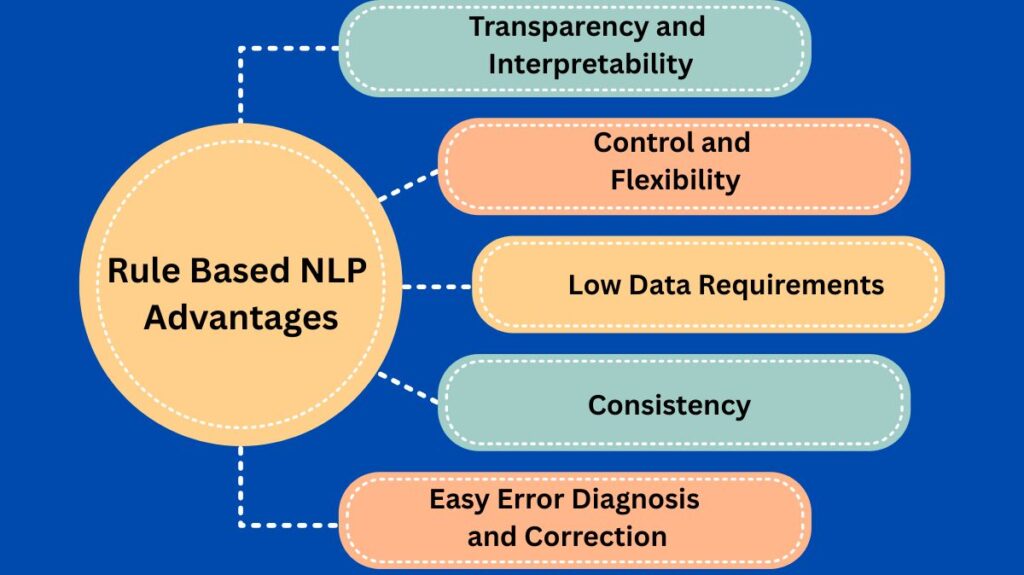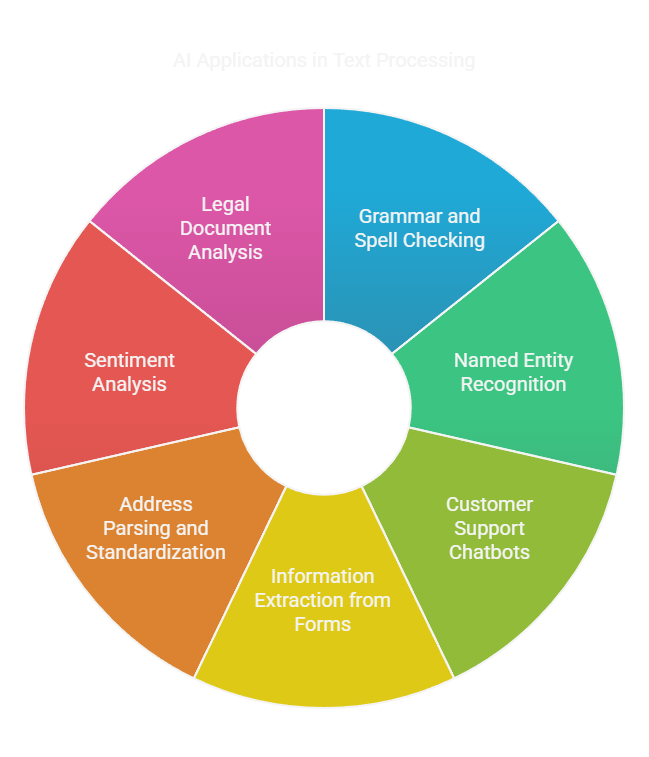Dive into the Rule Based NLP Example, Advantages And Disadvantages comparing its structured approach to machine learning techniques.
One method that uses clearly stated rules derived from human linguistic understanding is called rule-based natural language processing (NLP). Under this paradigm, a set of rules describing different linguistic phenomena, including grammar, syntax, and word patterns, are manually created by developers. The majority of early language processing efforts used logic, rules, and ontologies and were symbolic in nature.
The following are some important facets of rule-based NLP:
- Basis: Handcrafted rules built from linguistic expertise serve as the foundation for rule-based natural language processing. The goal of these principles is to capture linguistic structures and patterns.
- Development Process: Developing rule-based systems necessitates a substantial linguistic background and entails manually creating the rules. This manual labour can be rather taxing.
Applications and Methods:
- Rule-based systems manually apply a set of rules to text in Part-of-Speech (POS) tagging. Words that finish in “-ing” are usually gerunds, according to one example rule. The Brown corpus was first tagged using TAGGIT, a rule-based system.
- Rule-based chatbots create responses to user inputs by according to predetermined rules and patterns. For certain activities, they are said to be effective while being quite simple.
- Generative Grammar and Context-Free Grammars (CFGs), which are made up of rules or productions, can be used in parsing. These guidelines define the grouping and ordering of language symbols. Chart parsing uses a data structure to record rule applications, while LR parsing compiles the grammar into a finite automaton. Additionally, rules enhanced with constraints and feature terms are employed in constraint-based grammars.
- Finite state methods, such finite state transducers, are frequently used in morphological analysis to convey spelling or language rules.
- In its earliest stages (1950–1980), machine translation mostly depended on rule-based translation, which made use of dictionaries and linguistic rules. This method was frequently rigid and required a great deal of language expertise.
- Rule learning techniques can be used by Information Extraction (IE) systems to automatically extract patterns from annotated text. Lexical, syntactic, and semantic restrictions are examples of these rules, which can also be named sequential rules or regular expressions. Certain systems impose restrictions for tagging and correction.
Rule Based NLP Advantages
One benefit of rule-based systems is that they typically don’t need a lot of training data. High accuracy can be achieved in its design. Some rule-based learning systems, such as Transformation-Based Learning (TBL), produce a list of rules as their output, which are typically simple to understand linguistically. Model predictions can also be described by rule-based explanations.

Transparency and Interpretability
The interpretability and transparency of rule-based NLP systems are among their best features. The system can clearly relate every decision to a rule or set of rules.Developers and users can rapidly understand system input and output logic.
In regulated areas like healthcare, law, and finance, judgments must be auditable and explicable. Unlike deep learning models, which are “black boxes,” rule-based systems provide visible reasoning for their conclusions, boosting user and regulatory confidence.
Control and Flexibility
Fine-grained control and flexibility over language processing are provided by rule-based natural language processing. To address certain linguistic phenomena, commercial needs, or domain-specific terminology, developers can design custom rules.
It is simple to make changes: current rules can be changed or eliminated, and new rules can be added without impacting other system components. Rule-based systems are perfect for specialized applications where exact control over behavior is crucial, such medical text interpretation or legal document analysis, because of their versatility.
Low Data Requirements
Rule-based NLP can work well with little data, in contrast to machine learning models that need a lot of annotated training data.
The system does not require costly and time-consuming data labeling operations because it is based on expert knowledge that is encoded into rules. Because of this, rule-based methods are especially useful for low-resource languages, new disciplines, or specialized projects where access to huge datasets is limited. Additionally, it lowers the expenses related to data collecting and expedites the initial development period.
Consistency
The consistency of rule-based NLP is yet another important benefit. When a rule is put into practice, it consistently applies the same reasoning to all pertinent inputs.
Applications that need consistent data handling, such form validation systems, grammar correction tools, and legal compliance checks, depend on this predictability. Rule-based systems yield dependable and repeatable outcomes, while machine learning models can act inconsistently, particularly when dealing with edge cases or uncommon inputs.
Easy Error Diagnosis and Correction
Rule-based systems make it easy to identify and fix faults when they happen. Developers can identify the rule that caused the error, examine the reasoning behind it, and modify the rule as necessary.
Retraining a model or collecting fresh data, which may be costly and time-consuming in machine learning systems, is not required. For businesses that need regular updates or must swiftly adjust to shifting linguistic patterns or regulatory contexts, rule-based natural language processing (NLP) is especially appealing due to its ease of maintenance.
Rule Based NLP Disadvantages
Because rule-based systems might be brittle, they might not be able to adapt adequately to changes or unforeseen inputs. They are challenging to grow and maintain since they need skilled rule-writers. It can be difficult to manually define rules for every language phenomenon in a complicated real-world text, and this process may experience a knowledge acquisition bottleneck. Compared to statistical methods, they may also have trouble with the ambiguity that comes with natural language.
Rule-based NLP model substitutes
For complicated or dynamic NLP jobs, using a rule-based NLP model alone is frequently insufficient or suboptimal due to its advantages and disadvantages. As a result, a lot of NLP models employ additional or alternative methods that are grounded in statistics, data, or machine learning. These methods are able to learn from vast volumes of data and identify characteristics or patterns that rules are unable to identify. For instance, a neural network may be used by a data-driven natural language processing (NLP) model for sentiment analysis to learn from labelled texts and determine a polarity score based on the text’s tone and context.
Evolution and Hybrid Approaches
The majority of rule-based approaches in the field of natural language processing (NLP) have given way to more data-oriented approaches, especially those that depend on statistics and machine learning. Rule-based approaches are still useful, though, and are occasionally blended with statistical methods in hybrid systems. Rule-based systems, for example, can be used to create training data for machine learning models or to filter candidates prior to applying a statistical model. One approach that bridges the gap between statistical learning and human rule construction is Transformation-Based Learning (TBL), which learns corrective rules based on a quantitative criterion.
In contrast to the data-driven, quantitative techniques of statistical NLP, rule-based NLP is distinguished by its dependence on manually established linguistic rules [69, 73, Conversation History]. Rule-based approaches continue to be useful, occasionally incorporated into hybrid systems, and provide interpretability and high precision in particular situations despite difficulties with scalability and addressing ambiguity.
Rule Based NLP Example
A system that analyzes and processes text using pre-established linguistic rules is an example of rule-based natural language processing. Rules such as “words ending in ‘-ing’ are likely verbs” could be used by a rule-based part-of-speech tagger, for instance, to recognize and identify words. A rule-based chatbot that reacts to user input according to preset patterns and replies could serve as another illustration.

Grammar and Spell Checking
This use Natural Language Processing (NLP) models to identify and fix typos, difficult wording, and grammar errors in text. Artificial intelligence (AI) models trained on massive text corpora are used by programs like Grammarly and Word’s built-in spelling checker to recommend fixes.
Named Entity Recognition (NER)
With the NER technique, an AI model recognizes and categorizes important textual elements (entities), such as names of individuals, groups, dates, locations, etc. NER would mark “Apple” as an Organization and “September” as a Date in the sentence “Apple released a new iPhone in September,” for instance.
Customer Support Chatbots
These artificial intelligence (AI)-powered chatbots mimic human speech to help clients. They respond to frequently asked questions, solve simple difficulties, and occasionally refer more complicated ones to human agents. Chatbots on banking apps or e-commerce websites are two examples.
Information Extraction from Forms
AI models are able to extract particular data from semi-structured or structured documents, such as contracts, application forms, and invoices. For example, automatically extracting names, dates, or invoice amounts from a scanned PDF.
Address Parsing and Standardization
In order to do this, an address must be broken down into its constituent parts (street name, city, and postal code) and formatted uniformly. It is highly beneficial for lowering errors and increasing operational efficiency in databases, delivery services, and logistics.
Sentiment Analysis
AI evaluates content (such as reviews, tweets, or feedback forms) to identify whether it has a neutral, positive, or negative emotional tone. Companies use this to study public opinion, track brand reputation, and measure consumer happiness.
Legal Document Analysis
By automatically scanning contracts, recognizing important clauses, spotting dangerous words, and even suggesting changes, artificial intelligence (AI) assists attorneys and legal researchers. It facilitates the rapid review of large amounts of documents and expedites due diligence procedures.
